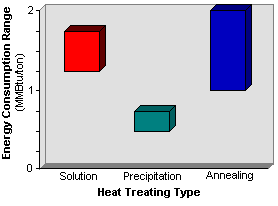Heat Treating: Energy Consumption
Equipment
Combustion Technology
Energy Consumption
Process Description
R&D Trends
Heat treating furnaces typically have thermal efficiencies ranging from 25%-50%. Overall energy consumption (per ton basis) depends on the type of operation: batch or continuous. The total energy consumption depends on the process temperature and soak time (the amount of time the metal is processed in the heat treating oven) requirements. Higher temperatures and longer soak times lead to increased energy consumption.
This figure illustrates typical specific energy consumption ranges for various types of aluminum heat treating.
Additional Equipment Information:
Midrex
In addition to its main vertical shaft furnace, the Midrex process utilizes the following major pieces of equipment in its production process:
Charge Feed System
The charge feed system introduces the charge into the top of the furnace.
Heat Exchanger
The heat exchanger preheats the gases prior to reforming.
Reformer
The reformer converts the natural and recycled gases into the reducing gas (hydrogen and carbon monoxide).
Cooling Gas Scrubber
The cooling gas scrubber recycles the cooling gases that exit from the DRI cooling zone of the furnace.
Top Gas Scrubber
The top gas scrubber recycles the furnace exhaust gases prior to combustion in the gas reformer.
Ejector Stack
The ejector stack rejects the scrubbed flue gases to the atmosphere.
HYL
The equipment most directly related to the DRI production in the HYL process is contained in the reduction and cooling circuits. Following is a list of major pieces of equipment.
Reduction Circuit
Reduction Zone – The reduction zone of the vertical reactor primarily removes oxygen from the iron ore with the reducing gases.
Quench Tower – The quench tower removes water from the reactor (top) exhaust gases.
CO2 Scrubber – The CO2 scrubber recycles reducing gas by removing CO2, before mixing with the reducing gas make-up.
Gas Heater – The Gas Heater heats the reducing gases to between 900-960°C before being fed into the reduction reactor.
Cooling Circuit
Cooling Zone – The cooling zone of the vertical reactor follows the reduction zone. This zone is used to cool and carburize the metallized DRI. The flow of DRI is controlled by a rotary valve at the exit of the cooling zone.
Quench Tower – The quench tower cools and removes water from the exhaust gas existing from the cooling zone. The gas exits the cooling zone at 490-540°C and is cooled to 40-45°C before entering the bottom of the cooling zone.
ACCAR
In addition to its main controlled atmosphere horizontal rotary kiln furnace, the ACCAR process utilizes the following major pieces of equipment in its production process.
Solid and Liquid Fuel Feed System – The solid and liquid fuel feed system introduces the fuels into the rotary kiln.
Rotary Cooler – The rotary cooler normally externally spray-cooled with water, to cool the DRI before discharging.
Magnetic Seperator – The magnetic seperator seperates the DRI from the coal ash.
Exhaust Gas Scrubbers – The exhaust gas scrubbers clean the exhaust gases before rejecting them to the atmosphere.
Ejector Stack – The ejector stack rejects the scrubbed furnace exhaust gases.
SL/RN
In addition to its main rotary horizontal kiln furnace, the SL/RN process utilizes the following major pieces of equipment in it production process:
Solids Feed System – The solids feed system introduces the solid fuels and charge into the feed end of the furnace.
Underbed Air Injection System – allows introduction of the process air into the preheating zone of the kiln.
Shell-Mounted Fans – The shell mounted fans introduce air into the freeboard to aid in maintaining a uniform reduction zone temperature.
Rotary Cooler – The rotary cooler, normally externally spray-cooled with water, cool the DRI before discharge.
Magnetic Seperator – The magnetic seperator seperates the final product into DRI, DRI fines, and non-magnetics, the char is seperated using gravity sepaeration.
Scrubbers – The scrubbers clean exhaust gases.
